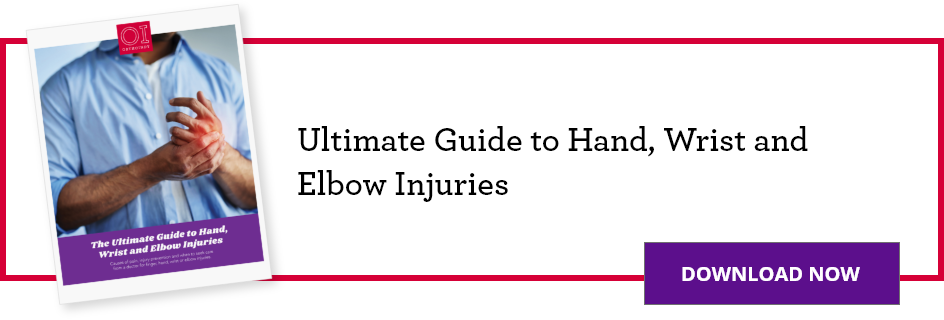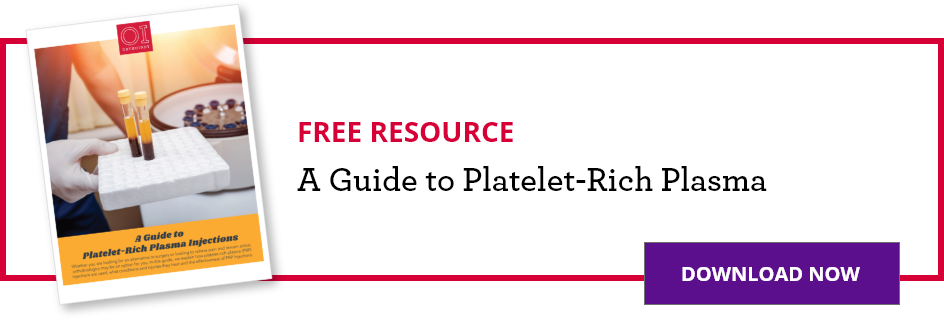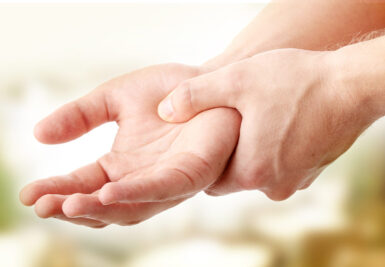THIS POST IS PART OF THE ULTIMATE GUIDE TO HAND, WRIST AND ELBOW INJURIES
Elbow arthritis occurs when your joint becomes inflamed and the cartilage holding your bones together gradually begins to break off and break down. This causes pain, stiffness and a limited range of motion. There are two kinds of arthritis in the elbow: osteoarthritis and rheumatoid arthritis.
Types of arthritis in the elbow
- Osteoarthritis: The most common arthritis found in the body is osteoarthritis. It usually only occurs in the elbow if there has been a past injury. Osteoarthritis is the gradual breaking down of cartilage typically from overuse or injury. When the cartilage breaks down, your bones start to rub together and small pieces of cartilage or bone break off, causing pain and stiffness in your elbow joint.
- Rheumatoid arthritis: This is an autoimmune disease. Your immune system has mistakenly sent cells to attack your own body. Rheumatoid arthritis affects the synovium, the tissue that lines your elbow joint. Cells attack and inflame the synovial fluid, which causes swelling and cartilage breakdown. If you don’t treat the inflammation of the synovium, your cartilage will begin to break down, then your bones will begin to rub together, and chips will break off.
Anatomy
The elbow joint connects the radius and ulna bones in your forearm to the humerus bone in your upper arm. The radius is on the thumb side of your arm and the ulna runs down the pinky side.
The three bones come together at the elbow and their ends fit in spaces called protrusions to form a hinge joint. A hinge joint can only move on one plane. For example, your elbow joint only flexes and extends front to back, not side to side.
Three ligaments, which are thick pieces of tissue that connect bones, run along the inside, outside and circle the top of your elbow. These ligaments surround the joint and form a capsule around it. A tissue called synovium lines the capsule and produces and holds synovial fluid. Synovial fluid surrounds the joint and the cartilage and aids the cartilage with lubrication of the joint and helps decrease friction when you move.
Shiny white cartilage, the cushion between your bones inside the joint, covers the end of each bone. You have cartilage so your bones don’t rub against each other and it also acts as a shock absorber.
What are the symptoms of arthritis in the elbow?
The following are common elbow arthritis symptoms:
- Pain
- Swelling (commonly rheumatoid arthritis)
- Instability
- Limited range of motion
- Stiffness
- Elbow locking or grinding (osteoarthritis)
- Tenderness in the joint (rheumatoid arthritis)
Some symptoms are more prominent in one type of arthritis than the other. But pain, stiffness and a limited range of motion account for both types.

How is arthritis in the elbow diagnosed?
To determine whether you have arthritis in your elbow your physician will ask you for a complete medical history, have you describe your symptoms and conduct a physical examination. An X-ray or MRI may be necessary to confirm the diagnosis and determine if there are other problems.
What are the treatment options for arthritis in the elbow?
Non-operative pain management will most likely be your physician’s treatment recommendation. There is no cure to arthritis, but several methods do not require surgery and can improve your symptoms.
- Change your daily routine
- Over the counter pain medication
- Physician directed physical therapy exercises
- Heat and ice
- Using a splint or brace
- PRP injection*
- Tissue and cell therapies*
*New studies show PRP and tissue and cell therapies can help reduce pain caused by osteoarthritis. Ask your physician if you’re a candidate for this orthobiologics option. These injections are not guaranteed to take effect, but when they work, they may help decrease pain and improve function.
http://
If surgery is necessary, you will discuss which surgery path to take with your physician.
- Elbow arthroscopy
- Synovectomy and removal of osteophytes
- Elbow fusion
- Elbow arthroplasty
Learn more about elbow pain treatment at OrthoIndy
Schedule an appointment
Your well-being is important to us. Click the button below or call us to schedule an appointment with one of our orthopedic specialists. If your injury or condition is recent, you can walk right into one of our OrthoIndy Urgent Care locations for immediate care. For rehabilitation and physical therapy, no referral is needed to see one of our physical therapists.





